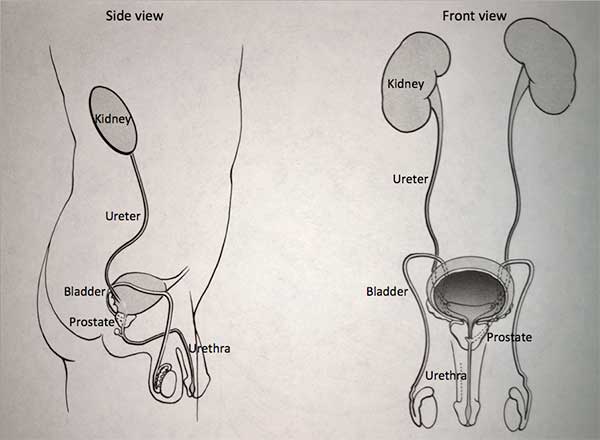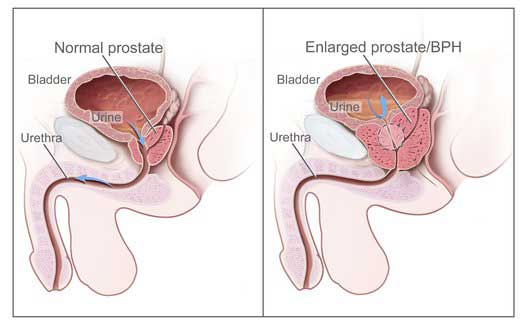Transurethral Resection of the Prostate (TURP)
How does the urinary system work?
The kidneys sit up in the back. They make the urine that runs through tubes down to the bladder. The bladder holds urine until full, and then empties to the outside through the urinary pathway. In men, the first part of the urinary pathway is the prostate, which is a gland that is part of the reproductive system, and makes some of the fluid that comes out at the time of ejaculation.

What happens to the prostate and bladder as men age? Why do men have to get up to pee at night?
When men reach 40, the prostate begins to enlarge and block the urinary pathway. As it blocks the urinary pathway, it can make it harder for the bladder to push the urine to the outside.

Men can notice symptoms that include hesitancy (harder to start the flow) decreased force of urinary stream, a sense of incomplete emptying, and dribbling at the end of urination. They may also note double voiding, which is the need to void, and then 10 minutes later, they need to go a second time.
At the same time that the prostate begins to enlarge, there are two other changes that may take place. The bladder gets smaller, so that it does not hold as much urine, and with smaller bladder capacity, men notice that they have to go more frequently. They may also have urgency, which is the sense of the need to go and they have less time to postpone urination.
The third change that takes place is the body holds on to fluid during the day, and then the kidneys get rid of the excess fluid at night. Increased frequency of urination at night can develop, because not only are the kidneys making more urine, the bladder holds less, so there is the need to go more often.
urologygroupvirginia.com/prostate-center/nocturia
Of these three changes - the enlarged prostate blocks the urinary pathway, the bladder gets smaller, and nighttime fluid production increases – the first step is to treat obstruction along the urinary pathway.
What can be done to address the urinary changes that men experience?
What can be done to address the urinary changes that men experience?
Pills are available to lessen the blockage along the pathway, and those details are summarized in the BPH newsletter. The alpha-blockers open up the pathway, by loosening the outer muscular grip of the prostate as it compresses the pathway. The 5 alpha reductase inhibitors reduce the size of the prostate, so that there is less crowding along the pathway.
When is it time for a man to have a procedure to the prostate?
When pills do not provide enough relief, when there are unwanted side effects, or if a man does not like taking pills, then there are different techniques available to open the urinary pathway. Other reasons to advance to a procedure include the onset of urinary retention (the inability to urinate, which requires catheterization) recurrent bleeding, or infection.
What is a TURP? How is it done? How long is the procedure?
One of the most common procedures used to remove blockage of the pathway by the prostate is the TURP, known as transurethral resection of the prostate.
The procedure is done under a regional or general anesthetic. The cystoscope (fiber-optic) is passed into the urethra, the urinary pathway in the penis. The enlarged parts of the prostate that block the pathway can be seen under direct vision. Those blocking parts of the prostate can be cut away or trimmed back, to open up the urinary pathway. A variation of TURP, called button TURP, uses an electrical device to smooth out and melt away the blocked part of the pathway. The end result is that the part of the prostate that blocks the pathway (and interferes with the ability of the bladder to push urine to the outside) is removed, so now there is an open urinary pathway without blockage.
A TURP procedure takes about 30 to 60 minutes. Some men require an overnight hospital stay, but many can be sent home on the day of the procedure. A catheter, a tube in the penis to drain urine to the outside to a bag, is typically left in place for 2 to 3 days, and then is removed in the office.
Most men are asked to stop one week in advance any mediations, which can promote bleeding, such as aspirin, and anti- inflammatory medications (i.e., Advil, Nuprin). If men are on Coumadin, which is a blood thinner, this should also be stopped one week in advance.
Postoperatively, men may notice for the first 6-8 weeks urinary frequency (the need to urinate more often), urgency (the need to urinate promptly once the urge is felt), and dysuria (burn or discomfort with urination). They may see blood that may develop on an intermittent basis over several weeks. Increased fluid intake is recommended during the first several weeks, preferably water, to promote increased urinary output. Strenuous exercise and heavy lifting, including bike riding, running on treadmills, working with vibrating equipment (e.g., riding a tractor mower), and engaging in sexual intercourse should be avoided for several weeks.
What are the risks?
The risk of general complications, such as heart and lung problems, is the same as for any other operation.
Potential hazards associated with the procedure include bleeding and infection. Most men develop retrograde ejaculation, also known as dry climax. Depending on the level of sexual function that they had preoperatively, they get the same quality of erection that they had before, and they have a sense of orgasm, but there is no fluid that comes out of the tip of the penis. Instead, the semen back washes into the bladder, and is washed out with the next urination. Retrograde ejaculation does not cause any harm to men, but some notice there is a diminished sense of climax.
What happens to urination after TURP?
When the urinary pathway is unblocked, the bladder can do a better job of emptying the urine to the outside. Most men notice improved force of urination, and a better sense of empty. Also, once the bladder muscle does not have to work as hard to push against a blocked pathway, the bladder muscle loses some of the thickening which developed when it had to work harder, and as the bladder muscle becomes less thick, and regains elasticity, it can improve its storage capacity, and hold more urine, which translates into less frequency and urgency.
For many of the men who have TURP, they can stop the medication they previously used to address urinary bother.
There is a subset of men who have a bladder that does not store well, which means it has low storage capacity, and even after TURP, they are still bothered with frequency and urgency. In that case, additional strategies are available to improve bladder storage, as outlined in the overactive bladder newsletter.
urologygroupvirginia.com/urologic-care/incontinence/overactive-bladder-sensory-urgency
Key message
Overall, TURP is a common procedure, and in properly selected patients, provides the opportunity to improve quality of life for those men who are troubled with urinary bother.
Print PageContact us to request an appointment or ask a question. We're here for you.



